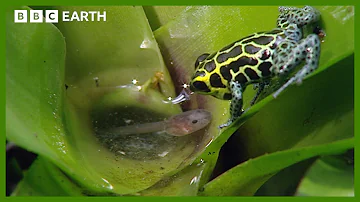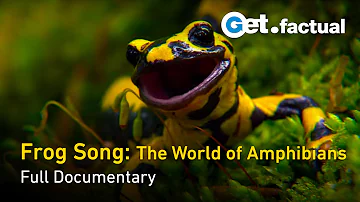
Golden Poison Frog
Phyllobates terribilis

Meet the Golden Poison Frog
The Golden Poison Frog is among the most toxic animals on Earth, native to the rainforests of western Colombia. Recognizable by its brilliant yellow, orange, or greenish coloration, this small amphibian serves as a warning to potential predators. Despite its tiny size, each frog can carry enough batrachotoxin to be lethal to several humans or large animals. In the wild, their toxicity comes from their specialized diet, and captive frogs do not develop the same level of poison.
Classification
Amphibian
Habitat
Tropical rainforest
Diet
Carnivore
Lifespan
6-10 years
Conservation
Endangered
Weight
1-2 grams
📖Fascinating Facts
Deadly Skin Toxins
The skin of the Golden Poison Frog contains batrachotoxin, one of the most potent natural toxins known to science.
Warning Colors
Their bright golden, orange, or green coloration acts as a visual warning to deter predators from eating them.
Indigenous Tool
Local indigenous people use the frog's toxins to coat the tips of blowgun darts for hunting.
📋Detailed Description
The Golden Poison Frog (Phyllobates terribilis) is a small but robust amphibian, typically measuring 47–55 mm (1.8–2.2 inches) in length, making it the largest species within its genus. Its skin is smooth and vividly colored, ranging from bright yellow (the most common morph) to orange or pale green, serving as a classic example of aposematic coloration to warn predators of its extreme toxicity. The frog's body is compact, with relatively short limbs and expanded toe pads that aid in climbing and gripping wet vegetation. Its eyes are large and positioned laterally, providing a wide field of vision for detecting prey and predators. Golden Poison Frogs are diurnal, being most active during daylight hours when humidity is high. They are primarily terrestrial, often found on the forest floor among leaf litter, but will occasionally climb low vegetation. Their diet in the wild consists mainly of small arthropods, such as ants, mites, and beetles, which are believed to be the source of their potent skin toxins. Socially, these frogs can be found in small groups, but males are territorial and will defend prime calling sites during the breeding season. Vocalizations are soft trills, used for both mate attraction and territory defense. The species exhibits complex parental care, with males often guarding eggs and transporting newly hatched tadpoles to suitable water bodies.
💡 Did you know?
Just one Golden Poison Frog contains enough toxin to kill up to 10 humans.
🔬Research & Sources
Wikipedia Summary
The golden poison frog, also known as the golden dart frog or golden poison arrow frog, is a poison dart frog endemic from the rainforests of Colombia. The golden poison frog has become endangered due to habitat destruction within its naturally limited range. Despite its small size, this frog is considered to be the most poisonous extant animal species on the planet.
Last Modified: 5/1/2025
🎭Behavior & Social Structure
Golden Poison Frogs are active foragers, employing a 'sit-and-wait' strategy interspersed with short bursts of movement to capture prey. They use their long, sticky tongues to snatch small invertebrates from the leaf litter. Males establish and defend territories, especially during the breeding season, using vocalizations and physical displays to deter rivals. Social interactions are generally limited outside of breeding, but some tolerance of conspecifics is observed in areas with abundant resources. Daily activity peaks during early morning and late afternoon, coinciding with optimal humidity. When threatened, the frogs rely on their bright coloration and toxic skin secretions as primary defenses, rarely resorting to flight. In captivity, they display less aggression and may form loose groups, though dominance hierarchies can develop.
👶Reproduction & Life Cycle
Breeding in Phyllobates terribilis is closely tied to the onset of the rainy season, typically from April to June in their native range. Males attract females with soft, high-pitched trills and will compete for optimal calling sites near water sources. After courtship, females lay clutches of 4–20 eggs on moist terrestrial substrates, such as under leaves or in crevices. The male guards the eggs, keeping them moist and protected from predators and fungal infection. Upon hatching (after 10–14 days), the male transports the tadpoles on his back to small pools or slow-moving streams, where they complete metamorphosis over 45–60 days. Parental care is primarily paternal, with males occasionally returning to check on tadpoles. Sexual maturity is reached at 12–18 months.
🛡️Adaptations & Survival
The Golden Poison Frog's most remarkable adaptation is its skin secretion of batrachotoxin, a potent neurotoxin that irreversibly binds to sodium channels in nerve and muscle cells, causing paralysis and death in predators. This adaptation is believed to have evolved through dietary specialization; the frogs sequester alkaloids from certain ants, beetles, and mites. Their aposematic coloration is a classic evolutionary strategy to deter predation. Physiologically, the frogs possess resistance to their own toxin via mutations in their sodium channel proteins. Behaviorally, their diurnal activity and terrestrial habits allow them to exploit a niche with fewer amphibian competitors. Their adhesive toe pads and strong limbs are well-suited for navigating wet, slippery substrates.
📚Research Sources
🎨Cultural Significance
The Golden Poison Frog holds significant cultural importance for indigenous Embera and Chocó peoples, who have traditionally used the frog's skin secretions to poison blowgun darts for hunting. The process involves carefully rubbing darts on the frog's back, transferring enough toxin to kill small game. The frog is also a symbol of the region's biodiversity and is featured in local folklore as both a dangerous and revered creature. In modern times, it has become an icon for conservation efforts in Colombia and a subject of fascination in herpetology and toxinology.
🔬Recent Research & Discoveries
Recent research has focused on the biochemical pathways of batrachotoxin synthesis and the genetic basis for toxin resistance in Phyllobates terribilis. Studies have confirmed that captive frogs lose their toxicity when fed a diet lacking specific alkaloid-rich arthropods, supporting the dietary hypothesis of toxin acquisition. Ongoing fieldwork is investigating population genetics, habitat requirements, and the impact of microclimatic changes on breeding success. Conservation genetics studies are underway to assess genetic diversity and inform captive breeding programs. Additionally, batrachotoxin is being studied for potential biomedical applications, including as a tool for understanding sodium channel function and as a model for developing novel analgesics.
🎥Wildlife Videos

Being a Poison Dart Frog Parent is HARD | 4K UHD | Seven Worlds One Planet | BBC Earth
Being a parent brings all sorts of challenges, but for the poison dart frog, remembering which tiny water pool you've left your ...
BBC Earth

The Insane Biology of: The Poison Dart Frog
Images Courtesy of Getty Images Thanks to our Patreon Supporters: Eric Ypsilantis Robert Thompson Keith Skipper Credits: ...
Real Science

The golden poison frog: 'Like holding a loaded gun' | Guardian Docs
Protecting it from extinction isn't an easy job – it lives among gold mines, drug runners, guerillas and local people sceptical of ...
The Guardian

Incredible Poison Arrow Frog Raises Tadpoles in the Treetops | BBC Earth
Raising tadpoles in the wild is no easy task. This tiny poison arrow frog has carried his young to the safe treetop pools. But when ...
BBC Earth

The Golden Poison Frog
Amazingly deadly!! #animals #wildlife #facts #nature #animalfacts #amphibian #frog #colombia #southamerica #poisonous #toxic ...
WinterWolf

Frog Song: The World of Amphibians - Full Documentary
Amphibians are living fossils in a modern world. The various species of frogs, toads, and salamanders are more diverse than you ...
Get.factual
🌍Habitat Information
The Golden Poison Frog typically inhabits Tropical rainforest environments. Golden Poison Frogs have adapted to their environments with specialized features and behaviors.
Primary Habitat:
Tropical rainforest
More detailed habitat information will be available soon.
🛡️Conservation Status
The Golden Poison Frog is currently classified as Endangered. Conservation efforts are crucial for preserving this species for future generations.
Common Threats:
- 🏠Habitat loss and fragmentation
- 🌡️Climate change impacts
- 🎯Hunting and poaching
- 🏭Human-wildlife conflict
⚠️Threats & Conservation Challenges
The primary threat to Phyllobates terribilis is habitat loss due to deforestation for agriculture, logging, and illegal gold mining in Colombia's Chocó region. Their extremely limited range (less than 5,000 km²) makes populations highly vulnerable to local disturbances. Illegal collection for the pet trade, although less common due to their toxicity, also poses a risk. Climate change may further threaten their specialized rainforest habitat. Population trends are declining, and the species is classified as Endangered by the IUCN. Conservation efforts are hampered by ongoing armed conflict and limited enforcement of protected areas.
🔬Scientific Classification
Scientific Name
Phyllobates terribilis
Classification Hierarchy
🔍 About Taxonomic Classification
Taxonomic classification is a hierarchical system used by scientists to classify and organize living organisms based on shared characteristics and evolutionary relationships.
The system moves from broad categories (Kingdom) to increasingly specific ones, with each animal's scientific name typically consisting of its Genus and species.
📝Community Notes
Share your observations and insights about the Golden Poison Frog with our community of wildlife enthusiasts.
Join Our Community
Sign in to share your observations and connect with fellow wildlife enthusiasts.
Sign In to ContributeNo community notes yet
Be the first to share your observations about the Golden Poison Frog!
Explore Golden Poison Frog
Select a tab above to learn more about this amazing animal.
📸Photo Gallery
No photos available for this animal yet.
🌟Discover More Wildlife
Continue your journey of discovery with more fascinating animals from our database
